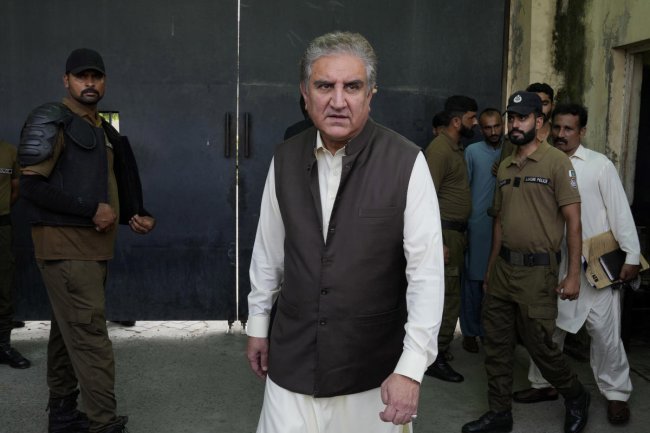‘Lady M’ and ‘Tosca’ Review: Verdi and Puccini Imagined Anew
Lisa Algozzini Photo: Russ Rowland By Heidi Waleson April 18, 2023 6:02 pm ET New York Heartbeat Opera, which specializes in rethinking classic titles for contemporary audiences, opened its first fully staged new productions in 3 1/2 years at the Baruch Performing Arts Center last week. The company has undergone changes. Its two founding artistic directors, Ethan Heard and Louisa Proske, left last year for posts at, respectively, Signature Theatre in Virginia and Oper Halle, Germany, and Heartbeat is now helmed by its musician co-founders, Jacob Ashworth and Daniel Schlosberg. Back in spring 2020, a few months after the Covid-19 pandemic had shut down in-person presentations and opera companies were scrambling to find alternatives, Heartb


Lisa Algozzini
Photo: Russ Rowland
By
Heidi Waleson
New York
Heartbeat Opera, which specializes in rethinking classic titles for contemporary audiences, opened its first fully staged new productions in 3 1/2 years at the Baruch Performing Arts Center last week. The company has undergone changes. Its two founding artistic directors, Ethan Heard and Louisa Proske, left last year for posts at, respectively, Signature Theatre in Virginia and Oper Halle, Germany, and Heartbeat is now helmed by its musician co-founders, Jacob Ashworth and Daniel Schlosberg.
Back in spring 2020, a few months after the Covid-19 pandemic had shut down in-person presentations and opera companies were scrambling to find alternatives, Heartbeat previewed bits of “Lady M,” its adaptation of Verdi’s “Macbeth” by Mr. Ashworth and Mr. Heard, on Zoom. Mr. Schlosberg’s weirdly creepy six-musician arrangement and a homemade video component made for a tantalizing tidbit. But staged in its fully realized, 90-minute form, now directed by Emma Jaster instead of Mr. Heard, “Lady M” is perplexing.

Isaiah Musik-Ayala
Photo: Russ Rowland
The adaptation has only three principal characters—Macbeth, Lady M and Banquo—plus three Sisters, who represent the witches, the chorus and everyone else. There are scene rearrangements and cuts, plus interpolations of spoken English text from the Shakespeare play. The most significant revision comes at the end: Macbeth’s final aria and his death are eliminated. Instead, we get Lady M’s sleepwalking scene, followed by the repositioned “Patria oppressa!” normally sung earlier by the chorus of Macbeth’s tormented subjects but here by the three Sisters and—Lady M. It is the only real clue to the renaming of the opera. Are we supposed to gather that she is sorry and is joining with those she has oppressed to make amends? What happened to her husband, the tyrant? Not clear.
The director’s note suggests that this is a feminist reinterpretation, but the rest of the staging fails to illuminate that concept. It is basically modern dress (costumes by Beth Goldenberg ), with a single rectangular block serving as a bed, a table, and (perhaps) a coffin; the most interesting element is the lighted halo that serves as a crown (scenic design by Afsoon Pajoufar ). A backdrop of hanging strips makes Camilla Tassi’s projections hard to see. Ms. Jaster’s direction is inscrutable—one choice was to have Lady M spend the sleepwalking scene Windexing the table (now glass topped, with Macbeth underneath it). Having the three Sisters ( Samarie Alicea, Taylor- Alexis Dupont and Sishel Claverie ) serve as the chorus as well as the witches, with no costume changes, was also confusing.

Sishel Claverie, Taylor-Alexis Dupont and Samarie Alicea
Photo: Russ Rowland
Mr. Schlosberg’s arrangement—violin, clarinet, trombone, percussion, guitar and electronics, which he led from the piano—didn’t help matters. Amplified and raucous in a live setting, it relentlessly called attention to the ugliness of the story. The bass clarinet and the trombone, which are inherently comical instruments, sometimes even undermined the seriousness of the plot; and the poor violin was unable to tip the atmosphere toward lyricism. Still, the manic activity of the band, with much instrument-switching going on, was livelier than what was seen onstage.
The singers made the noise level in this small theater even harder to bear. Lisa Algozzini has the dramatic soprano capacity for Lady M, but she offered no subtleties of expression, and Kenneth Stavert shouted his way through Macbeth. Bass-baritone Isaiah Musik-Ayala displayed a welcome warmth of timbre as Banquo, but his role is small. Ms. Alicea, who had lost her voice and was unable to sing, acted while Victoria Lawal sang some of her music from the orchestra, adding to the general weirdness.

Christopher Nazarian, Masih Rahmati, Reza Mirjalili, Chad Kranak and Joe Lodato
Photo: Russ Rowland
Heartbeat’s “Tosca” was more coherent, though one had to read the program note in advance to understand director Shadi G.’s concept: A theater group in a fundamentalist theocracy is putting on the Puccini opera. It becomes a protest as the performers gradually flout the state’s morality rules governing the performance, which include mandated hair coverings for women as well as prohibitions against men and women touching, or a woman killing a religious authority onstage.
More Opera Reviews
- ‘Champion’ Review: Terence Blanchard Comes Back to the Met April 12, 2023
- ‘Proximity’ and ‘The Life and Death(s) of Alan Turing’ Reviews: A Weekend of World Premieres March 27, 2023
- ‘A Thousand Splendid Suns’ Review: Arias in Afghanistan March 6, 2023
- ‘Lohengrin’ Review: Color-Coded Wagner at the Metropolitan Opera February 28, 2023
The production is clever. Two undercover policemen watch from the shadows and occasionally shout at the performers or hustle them offstage. Their menace is subtle but palpable—the torture scenes take on new relevance— and by Act 3 they have become part of the execution squad, leaving us to wonder if the “actor playing Cavaradossi,” as he is listed in the program, is actually shot dead at the end. With each act, the costumes (by Mika Eubanks ) acquire more modern elements, and the Act 3 rooftop overlooks downtown Tehran (the scenic design is by Reid Thompson ). The performers, changing the set after Act 1, sing a Farsi poem set to the Chilean protest tune known in English as “The People United Will Never Be Defeated”; later, it is repeated as a solo in lieu of the shepherd’s song at the beginning of Act 3, accompanied by a kamancheh, an Iranian bowed string instrument. Tosca’s final act of defiance is to leap atop a graffiti-scrawled wall and tear off her headscarf. Significantly, she doesn’t jump.
Mr. Schlosberg’s orchestral arrangement—three cellos, bass, flute, horn, trumpet and piano—conducted by Mr. Ashworth, sounded a bit scrappy, but it got the job done. Trimmed to 100 minutes, the score is moderately cut, most notably eliminating Cavaradossi’s “Recondita armonia” and the chorus parts—other than a pre-recorded, men-only ensemble that thundered the “Te Deum” at the conclusion of Scarpia’s “Va, Tosca!” Anush Avetisyan was a fiery Tosca, Chad Kranak an ardent Cavaradossi, and Gustavo Feulien
—Ms. Waleson writes on opera for the Journal and is the author of “Mad Scenes and Exit Arias: The Death of the New York City Opera and the Future of Opera in America” (Metropolitan).
What's Your Reaction?













